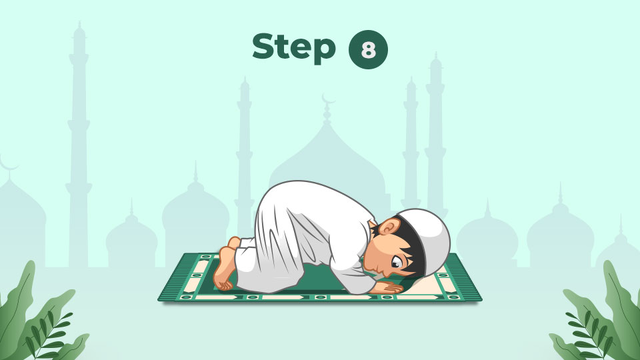What is Salah?
Salah is a particular form of devotion that, after the shahada, is the second most fundamental pillar of Islam (testimony of faith).
It is a five-times-a-day mandatory form of prayer given in al Quran al Kareem and taught to us by Prophet Muhammad (Peace Be Upon Him).
With a variety of physical actions such as standing, bowing, prostrating, and sitting, the salah unites you with Allah SWT.
It also entails reciting passages from the Holy Quran in Arabic, as well as reciting a number of dua (supplications).
Muslims begin salah by facing the direction of the Kaaba, Allah’s Sacred House in Makkah, whenever they pray.
All of these physical gestures, recitations, and supplications are performed to demonstrate humility and obedience to Allah SWT.
Why Do We Pray?
The reason Muslims pray at all is that Islam believes that the aim of life is to worship Allah SWT alone.
The observance of salah (worship) was one of the first commands revealed to prophet Muhammad by Allah shortly after he became a Prophet.
Allah Almighty tells us in the Holy Quran that mankind was only created for one reason: to worship Him.
“And I ( Allah) created not the jinns and humans except they should worship Me (Alone).”
(Surah Ad-Dhariyat)
Types of Salah
Obligatory
In Islam, the mandatory prayers are five that should be performed throughout the day. A Muslim who fails to perform these prayers with no valid reason is considered a sinner.
Our beloved Prophet (Peace Be Upon Him) said:
“Between a man and polytheism and disbelief, there stands his neglect of the prayer.”
These prayers include:
Fajr: the dawn prayer. It is a two Rakat Salah.
Dhuhr: the early afternoon prayer. It is a four Rakat Salah.
Asr: the late afternoon prayer. It is a four Rakat Salah.
Maghrib: the sunset prayer. It is a three Rakat Salah.
Isha: the night prayer. It is a four Rakat Salah.
Additional Prayers
Other additional prayers that are also notable in Islam:
Jumuah prayers: weekly congregational prayer (replaces Dhuhr on Fridays with two Rakat along with khutba from Shaykh) a male Muslim,
who misses two consecutive Jumuahs is considered a sinner.
Sunnah: These prayers are encouraged to be performed on a regular basis during the Prophet’s lifetime.
2 Rakat Sunnat for Fajr (The Fajr sunnah is offered before Fajr prayers, and Duha prayer after sunrise.)
4 Rakat Sunnat for Zuhr (The Zuhr sunnah is 4 rakats before Zuhr and 2 rakats after zuhur.)
4 Rakat Sunnat for Asr (The sunnah for Asr is offered before Asr prayer.)
2 Rakat Sunnat for Maghrib (The sunnah for maghrib should be offered after Maghrib prayers.)
4 Rakat Sunnat for Isha (The sunnah for Isha is 4 Rakat before Isha and 2 Rakat after: named Chafaa and followed by 1 Rakat of Witr.)
Nawafil Prayers
In Islam, Nawafil prayers are supererogatory prayers. They, like sunnah prayer, are not considered obligatory.
but are thought to bestow an additional advantage on the individual who does them. According to Rabi’ah ibn Malik al-Aslami, the Prophet (Peace Be Upon Him) said:
“Ask (anything).” Rabi’ah said: “I ask of you to be your companion in paradise.” The Prophet (PBUH) said: “Or anything else?” Rabi’ah said: “That is it.” The Prophet (PBUH) said to him: “Then help me by making many prostrations (Supererogatory prayers)”.
(Muslim)
These Nafl prayers include:
Tahajjud prayers (night prayers): There is no set quantity of rakaat in Tahajjud; instead, you should pray as much as you can.
“The best prayer after the obligatory prayers is the night prayer.”
(Muslim)
Salat al-Duha: It is often performed in the middle of the morning or late in the morning. This is its most commonly mentioned name in the narrations.
When the sun is shining brightly, it is a late-morning prayer.
Salat al-Ishraq: is known as the “sunrise prayer,” or the prayer performed around 20 minutes after sunrise.
Tahiyyatul Masjid: nafl prayer of 2 rakaat when entering the mosque.
How To Introduce Prayer (Salah) For Kids?
Lots of parents ask about the best way to introduce their kids to Salah and how to make it an unconscious practice of their daily lives.
This can be achieved by following these tips below:
Let Them See You Pray
Because your child observes and absorbs your actions more than your words, the example you set as a parent is critical. Even though it appears that your children are not following your example, they are, and it will be stored in their memory banks even after they grow up.
Make sure they see you praying Fajr on time, then praying Dhur or Asr when you get home from work even if you’re tired, then praying Ishaa when it gets dark, and so on. Salah will be engraved in their minds as an important practice that should be respected no matter what.
Even when you’re outside for a picnic or a road trip as a family, tell them that being outside is not an excuse to miss Salah. Use their help to find a good spot to pray and perform prayers in front of them.
Salah is a particular form of devotion that, after the shahada, is the second most fundamental pillar of Islam (testimony of faith).
It is a five-times-a-day mandatory form of prayer given in al Quran al Kareem and taught to us by Prophet Muhammad (Peace Be Upon Him).
With a variety of physical actions such as standing, bowing, prostrating, and sitting, the salah unites you with Allah SWT.
It also entails reciting passages from the Holy Quran in Arabic, as well as reciting a number of dua (supplications).
Muslims begin salah by facing the direction of the Kaaba, Allah’s Sacred House in Makkah, whenever they pray.
All of these physical gestures, recitations, and supplications are performed to demonstrate humility and obedience to Allah SWT.
Why Do We Pray?
The reason Muslims pray at all is that Islam believes that the aim of life is to worship Allah SWT alone.
The observance of salah (worship) was one of the first commands revealed to prophet Muhammad by Allah shortly after he became a Prophet.
Allah Almighty tells us in the Holy Quran that mankind was only created for one reason: to worship Him.
“And I ( Allah) created not the jinns and humans except they should worship Me (Alone).”
(Surah Ad-Dhariyat)
Types of Salah
Obligatory
In Islam, the mandatory prayers are five that should be performed throughout the day. A Muslim who fails to perform these prayers with no valid reason is considered a sinner.
Our beloved Prophet (Peace Be Upon Him) said:
“Between a man and polytheism and disbelief, there stands his neglect of the prayer.”
These prayers include:
Fajr: the dawn prayer. It is a two Rakat Salah.
Dhuhr: the early afternoon prayer. It is a four Rakat Salah.
Asr: the late afternoon prayer. It is a four Rakat Salah.
Maghrib: the sunset prayer. It is a three Rakat Salah.
Isha: the night prayer. It is a four Rakat Salah.
Additional Prayers
Other additional prayers that are also notable in Islam:
Jumuah prayers: weekly congregational prayer (replaces Dhuhr on Fridays with two Rakat along with khutba from Shaykh) a male Muslim,
who misses two consecutive Jumuahs is considered a sinner.
Sunnah: These prayers are encouraged to be performed on a regular basis during the Prophet’s lifetime.
2 Rakat Sunnat for Fajr (The Fajr sunnah is offered before Fajr prayers, and Duha prayer after sunrise.)
4 Rakat Sunnat for Zuhr (The Zuhr sunnah is 4 rakats before Zuhr and 2 rakats after zuhur.)
4 Rakat Sunnat for Asr (The sunnah for Asr is offered before Asr prayer.)
2 Rakat Sunnat for Maghrib (The sunnah for maghrib should be offered after Maghrib prayers.)
4 Rakat Sunnat for Isha (The sunnah for Isha is 4 Rakat before Isha and 2 Rakat after: named Chafaa and followed by 1 Rakat of Witr.)
Nawafil Prayers
In Islam, Nawafil prayers are supererogatory prayers. They, like sunnah prayer, are not considered obligatory.
but are thought to bestow an additional advantage on the individual who does them. According to Rabi’ah ibn Malik al-Aslami, the Prophet (Peace Be Upon Him) said:
“Ask (anything).” Rabi’ah said: “I ask of you to be your companion in paradise.” The Prophet (PBUH) said: “Or anything else?” Rabi’ah said: “That is it.” The Prophet (PBUH) said to him: “Then help me by making many prostrations (Supererogatory prayers)”.
(Muslim)
These Nafl prayers include:
Tahajjud prayers (night prayers): There is no set quantity of rakaat in Tahajjud; instead, you should pray as much as you can.
“The best prayer after the obligatory prayers is the night prayer.”
(Muslim)
Salat al-Duha: It is often performed in the middle of the morning or late in the morning. This is its most commonly mentioned name in the narrations.
When the sun is shining brightly, it is a late-morning prayer.
Salat al-Ishraq: is known as the “sunrise prayer,” or the prayer performed around 20 minutes after sunrise.
Tahiyyatul Masjid: nafl prayer of 2 rakaat when entering the mosque.
How To Introduce Prayer (Salah) For Kids?
Lots of parents ask about the best way to introduce their kids to Salah and how to make it an unconscious practice of their daily lives.
This can be achieved by following these tips below:
Let Them See You Pray
Because your child observes and absorbs your actions more than your words, the example you set as a parent is critical. Even though it appears that your children are not following your example, they are, and it will be stored in their memory banks even after they grow up.
Make sure they see you praying Fajr on time, then praying Dhur or Asr when you get home from work even if you’re tired, then praying Ishaa when it gets dark, and so on. Salah will be engraved in their minds as an important practice that should be respected no matter what.
Even when you’re outside for a picnic or a road trip as a family, tell them that being outside is not an excuse to miss Salah. Use their help to find a good spot to pray and perform prayers in front of them.















